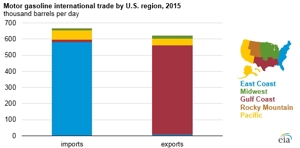EIA: Regional refining capacity makes US major importer and exporter of gasoline
The US simultaneously imports and exports gasoline, because of regional differences in gasoline supply and demand balances. The two regions with the largest supply and demand imbalances are the East Coast, which imported 581 Mbpd of gasoline in 2015, and the Gulf Coast, which exported 551 Mbpd of gasoline in 2015.
Regional supply and demand balances in these two regions are described in detail in EIA's recent PADD 1 and PADD 3 Transportation Fuels Markets report. East Coast (defined as Petroleum Administration for Defense District, or PADD, 1) refining capacity is below consumption, and to meet demand gasoline must be shipped in from other parts of the United States and from international sources. Refining capacity in the Gulf Coast (PADD 3) exceeds demand, allowing the region to send gasoline elsewhere in the US and to export internationally.
Patterns of international trade in gasoline in all US regions are also affected by transportation constraints and shipping regulations. Pipelines between the Gulf Coast and East Coast already operate at or near full capacity, while maritime regulations can add significantly to the cost of marine movements between US ports.
The East Coast had the highest gasoline consumption in the country at 3.2 MMbpd in 2015. However, refinery production in the region was only 550 Mbpd in 2015. To meet demand, the East Coast receives gasoline via pipeline and marine shipment from Gulf Coast refineries. Approximately 1.9 MMbpd of gasoline, or 60% of East Coast gasoline demand, came from the Gulf Coast in 2015. The East Coast also imports gasoline from other countries, predominantly from Western Europe and Canada. Imports into the East Coast accounted for 87% of total US gasoline imports in 2015.
Unlike refinery capacity on the East Coast, capacity in the Gulf Coast exceeds demand. In 2015 Gulf Coast refinery gasoline production was approximately 4 MMbpd, while demand was approximately 1.5 MMbpd. The Gulf Coast sends its surplus gasoline to other regions in the United States and to foreign markets. The Gulf Coast exported more than 89% of total U.S. gasoline exports in 2015. The primary destinations for Gulf Coast exports were to other countries in North America and Central and South America accounting for 51% and 35% of total US gasoline exports, respectively. Refineries on the US Gulf Coast have increasingly exported gasoline to Central and South America in recent years, but they face increased competition as new and upgraded refineries in that region come online and likely decrease the need for imports.







Comments